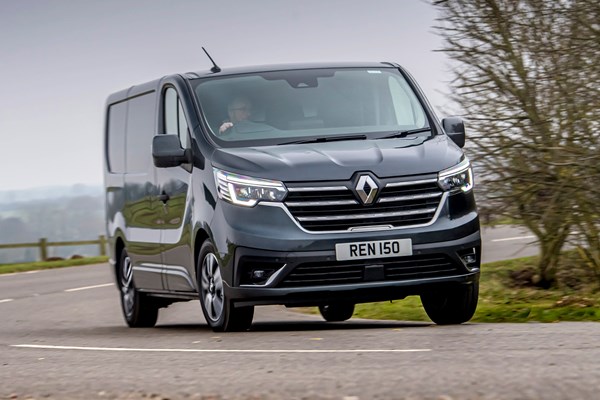Renault Trafic van review (2023)
2022 facelift brings big safety boost for this clever, comfortable medium van
PROS
- 2022 facelift brings massive safety boost
- Longest medium van loading length
- Comfortable and good to drive
- Cost effective real-world fuel economy
- Clever interior features, neat design
CONS
- Rivals offer higher payload
- Lots of painted bodywork
- Older versions lack safety aids
- Some slow engines
- Fiddly infotainment
Summary
The 2023 Renault Trafic is one that has been recently upgraded, with the most recent facelift in 2022 improving not only the way it looks outside and in, but also bringing a significant improvement in available safety equipment. We have driven the new Trafic here in the UK, as well as many previous versions of this medium van, which has been on sale since 2014.
The Trafic competes against the likes of the Ford Transit Custom and the Volkswagen Transporter. It was previously updated in 2019, when the original 1.6-litre engines were replaced by the new 2.0-litre turbodiesels that form the basis of the current range. These offer up to 170hp and the option of an appealing six-speed automatic gearbox.
What's new for the 2022 Renault Trafic?
The front of the New Trafic – as Renault is calling it – is ‘completely new’. Alongside that big grille there is full LED lighting with Renault’s signature C-shaped daytime running lights, and beneath it there’s a redesigned front bumper, described as ‘elegant and dynamic’.
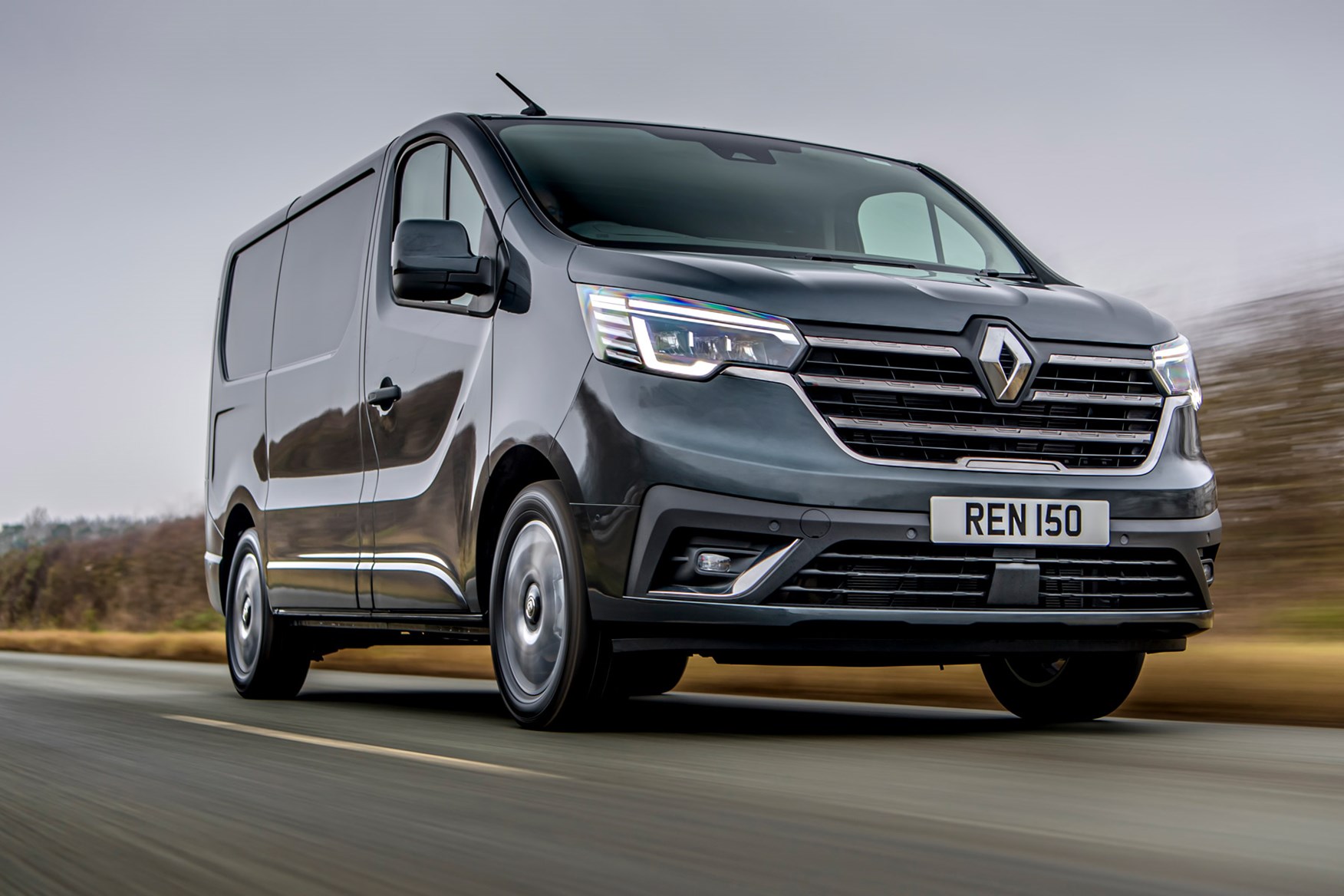
There are no changes at the rear, but as before, the updated Trafic comes in two lengths and two roof heights. The trim structure has been revised a couple of times. Immediately after the facelift in early 2022 it came with a new Sport+ model at the top, above the familiar Sport, Business+ and Business. In 2023 these are now renamed Start, Advance, Extra and Extra Sport.
On the inside, there’s a new dashboard with an emphasis on horizontal lines, better quality door panels with wider armrests, new gear lever and new instrument panel. Infotainment options are brought bang up-to-date with Renault's car range, which also lends the Trafic a number of interior trim parts.
Much safer than before
Most significantly of all, however, the prior version of the Renault Trafic was heavily criticised by the Euro NCAP crash safety body because of its lack of active safety kit – to the extent that it was actually ‘not recommended’.
This updated New Trafic has taken serious steps towards correcting this, and is now available with a substantial number of Advanced Driver Assistance Systems (ADAS), including autonomous emergency braking (which Renault refers to as active emergency braking).
Renault Trafic strengths and weaknesses
Strengths include the impressively comfortable and car-like driving experience, good real-world fuel economy, and the joint-longest loading length in the mid-size van sector, alongside its sister van the Nissan NV300. This is essentially the same as the Trafic (and built by Renault), though the Nissan comes with a five-year warranty as standard.
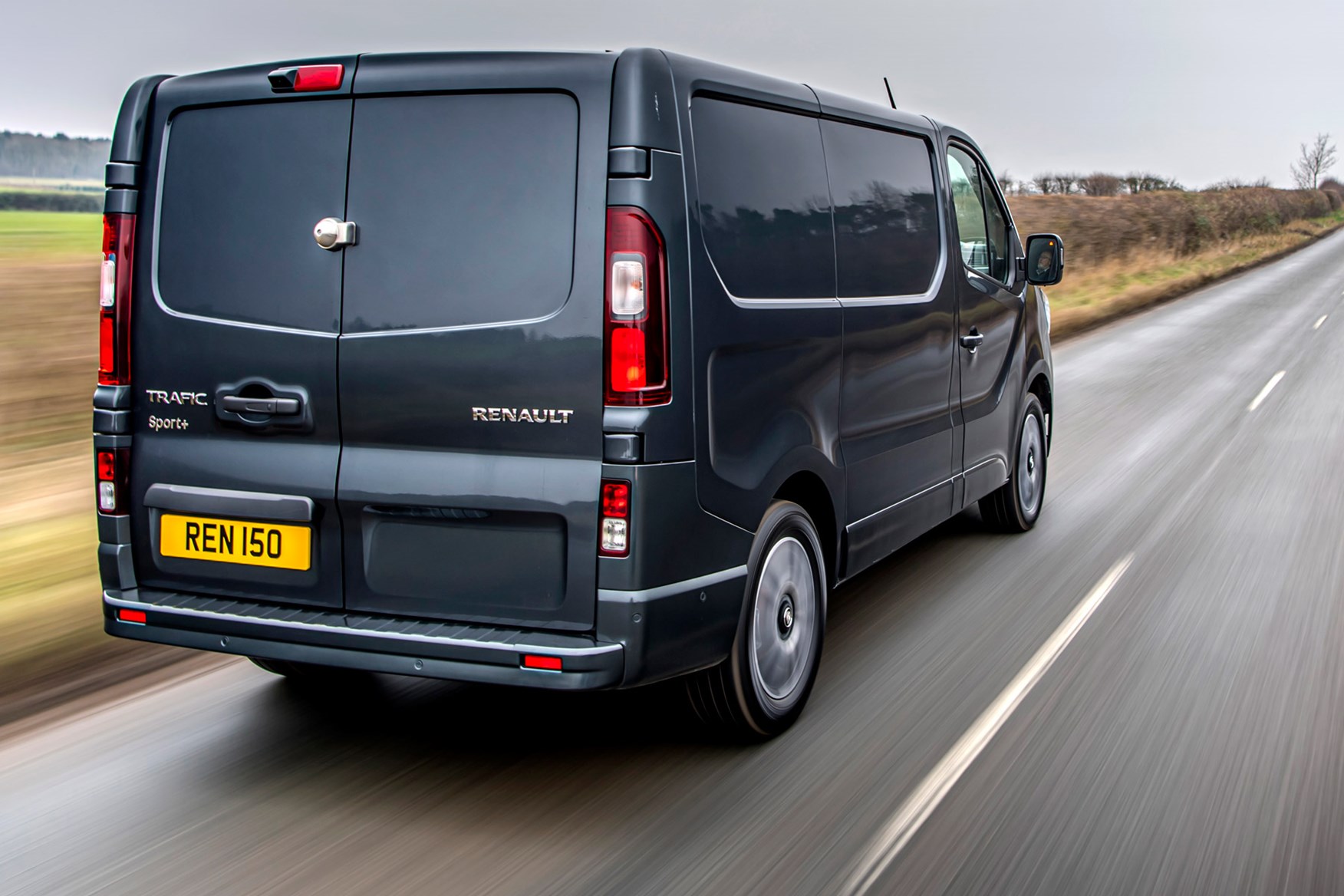
Up until 2019, the Vauxhall Vivaro was also based on the Renault Trafic (though built in Luton rather than France). But with a change of ownership making the British brand part of the former Peugeot-Citroen PSA Group (now renamed Stellantis) a newer Vivaro has been launched based on the same platform as the Citroen Dispatch, Peugeot Expert and Toyota Proace. This was also true for the Fiat Talento, but the same happened in 2021 as Fiat also joined the Stellantis group.
In terms of weaknesses, you will find that many rivals are available with higher payload ratings. And as we've mentioned, older versions didn't have the gratest safety rating.
Renault Trafic bodystyles and variants
The Trafic comes in two lengths and two roof heights, making a total of four body variants.
It’s also sold as a panel van, a crew van (with second row of seats) and as the Trafic Passenger, essentially a compact minibus with up to nine seats. A platform cab for conversions is also available, as well as a 'luxury' passenger carrier called the SpaceClass, which competes against the Volkswagen Multivan.
A load-through flap in the bulkhead means items such as pipes up to 4.15m in length can be accommodated. This is fitted as standard on most models.
Full details of load area capacity are listed on our dedicated Renault Trafic dimensions page.
Verdict: Is the Renault Trafic any good?
The Renault Trafic is a good choice of medium van if you don’t need the highest possible payload ratings. The latest version looks sharp, offers safety kit that's right at the top of the class, and has a broader range of engines, all of which meet the very latest Euro 6 emissions regulations. The 2022-onwards interior is a big improvement, too.
Keep reading for full details of every area of this very much modernised medium van.
Skip to our full verdict on...
- Good to drive, with comfortable suspension and precise steering
- 2.0-litre engines now offers 110-170hp, excellent automatic gearbox
- Older 1.6-litre models still perform well, but go for a twin-turbo
The Transit Custom is generally thought of as the gold standard for medium van driving enjoyment, but the Renault Trafic and its extended family push the Ford hard. This is a really nice van to drive.
Renault Trafic comfort and handling
With suspension similar to Renault’s MPV passenger cars, the Trafic rides bumps well, is quiet at speed and doesn’t go all wobbly in the corners. In fact, you can drive this front-wheel drive van surprisingly quickly, thanks to the accurately weighted steering and a limited amount of body roll.
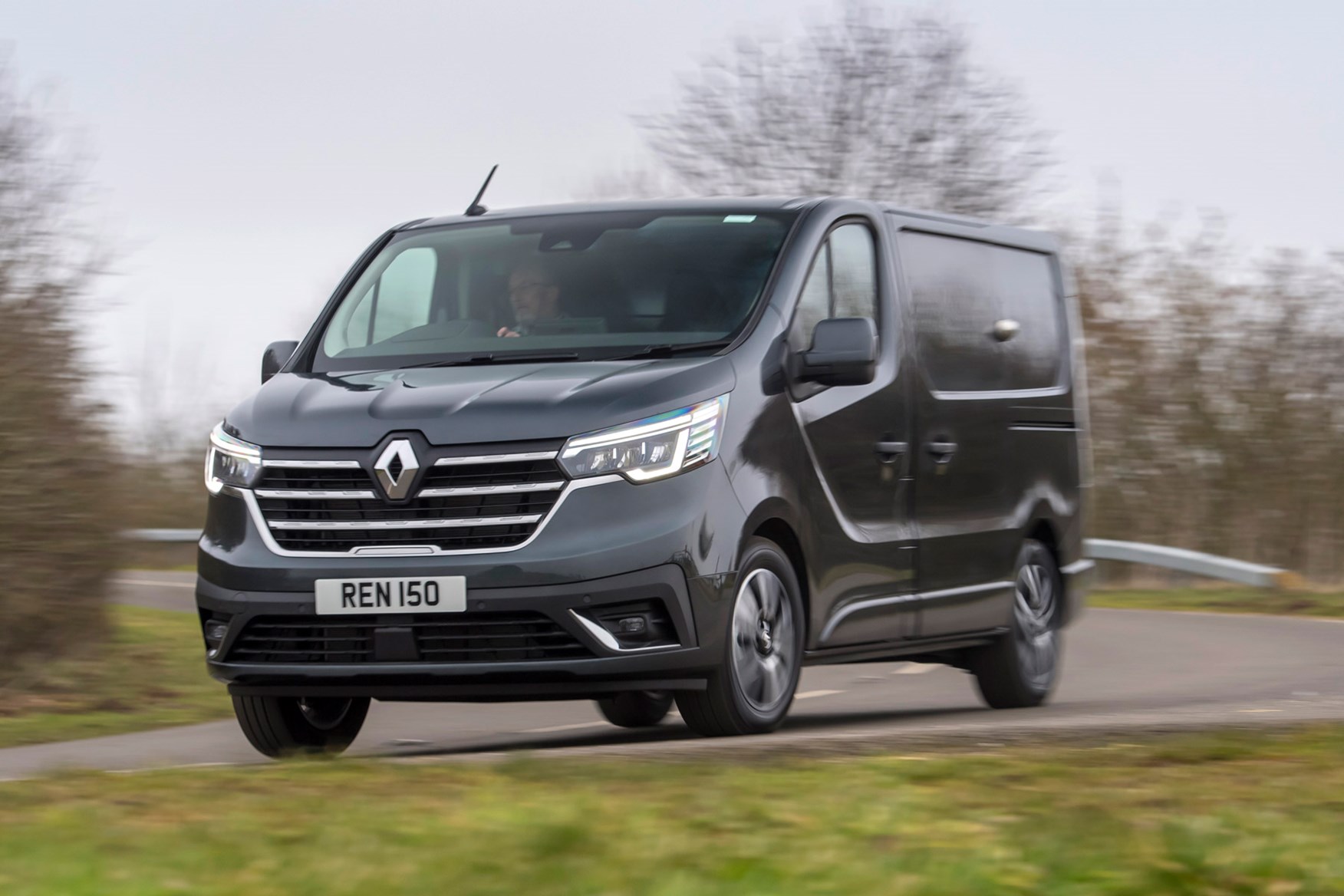
There are no changes to the way the suspension is set-up for the latest update, so the newer models drive largely the same - although the additional weight of the 2.0-litre engines over the front wheels does seem to make the Trafic feel a little less light on its feet than the 1.6 models did.
The steering is heavier than you'll find in a lot of modern vans, too. Not so heavy that you can't easily handle the van around town, but still noticeably weighty.
Overall, the level of control gives you plenty of confidence when positioning the van on the road, and you might even find yourself enjoying the experience - especially in Trafics fitted with the EDC automatic gearbox. More on that in a moment.
What are the Renault Trafic 2.0-litre diesel engines like?
The 2.0-litre diesel engines introduced with in July 2019 came in three power outputs:
- dCi 120 with 120hp / 320Nm
- dCi 145 with 145hp / 350Nm
- dCi 170 with 170hp / 380Nm
Following the January 2022 New Trafic update, this changed slightly, with a new entry-level output and increase in power for the middle-ranking models:
- Blue dCi 110 with 110hp / 300Nm
- Blue dCi 130 with 130hp / 330Nm
- Blue dCi 150 with 150hp / 350Nm
- Blue dCi 170 with 170hp / 380Nm
We've not sampled the least powerful variants, but the 130hp model is more than up to the task of shifting this size of van reasonably vigorously, while the 145hp (now 150hp) and 170hp versions feel very keen indeed. Especially when combined with the six-speed automatic gearbox that's optional on those outputs.
To such an extent that we'd be very tempted to opt for a 145hp or 150hp auto over a 170hp model with the standard six-speed manual transmission (although the auto would still be more expensive, so it's not a direct comparison).

The reason for this is the awesome effectiveness of the automatic transmission, which is called EDC - Efficient Dual Clutch - and works like Volkswagen's DSG system. It shifts very smoothly, very quickly and does a great job of keeping the engine on the boil, allowing you to make seemingly effortless progress.
The manual override available by pushing the gear selector to the right even works like a racing car, which is to say you pull back to change up and push forward to change down, adding to the experience. Yes, we know - it's just a van, but that doesn't mean you can't have a bit of fun driving it.
The engines themselves don't seem to be quite as refined as the old 1.6-litre units, but with variable geometry turbos they are certainly responsive, and the bigger capacity is better for real-world fuel economy.
As for the manual gearbox, this is reasonable in van terms but not quite as mechanically precise as we'd like, and we suspect it will feel increasing loose as the miles pile on.
What are the Renault Trafic 1.6-litre diesels like?
When this Trafic was launched in 2014 with 1.6-litre engines, it joined a class where most rivals were still using 2.0-litre motors.
Renault's decision followed the 'downsizing' trend of fitting smaller engines to achieve better fuel economy then current across the automotive industry. We've never thought this was bad move on Renault's part, as we've always enjoyed driving the 1.6-litre Trafics.
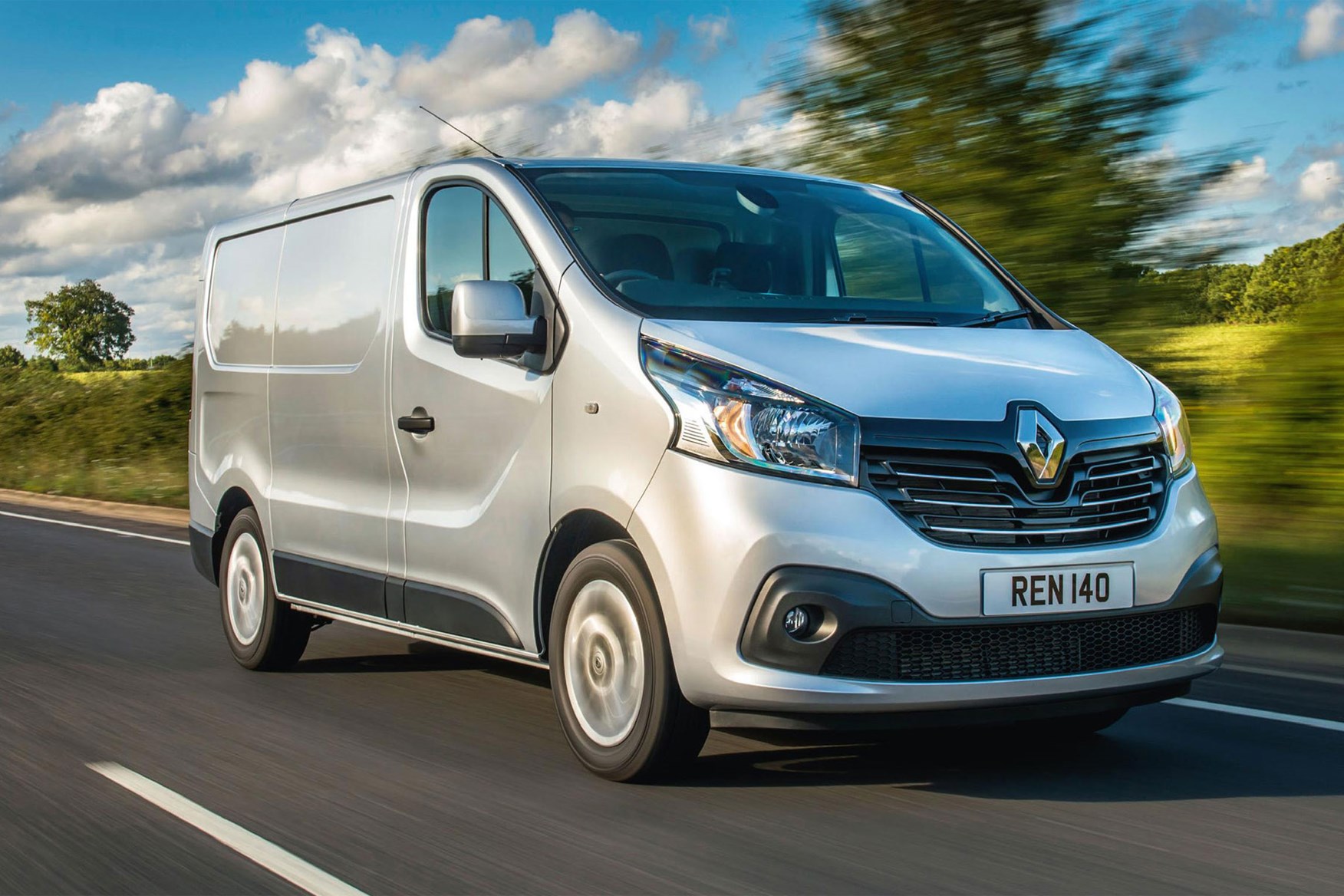
The best choices are certainly the twin-turbo models, however. Offering 120hp or 140hp in Euro 5 guise and 125hp or 145hp when upgraded to Euro 6 from late 2016 onwards, alongside 320Nm or 340Nm of torque (regardless of emissions standard), these are smooth, refined and easily grunty enough to shift their maximum payloads.
The cheaper single-turbo versions come with either 90hp or 115hp at Euro 5 levels, 95hp or 120hp at Euro 6. With a relatively slight 260Nm, the very entry-level models are going to feel a little overwhelmed in some circumstances, but the more powerful ones have a useful 300Nm so should do most jobs well.
What the single-turbo models aren't is as refined, effortless or economical. We’d definitely go twin-turbo given the option.
- Car-like cab design that looks and feels good quality
- Android Auto and Apple CarPlay available
- Large amounts of storage, now more practical
The Trafic has always had a car-like interior that borrows heavily from Renault's passenger car range while also offering a large amount of storage space - even if this storage hasn't always been the most obvious. For the 2022 facelift, both facets have been further refined, with a striking new design inside that also offers greater functionality.

This is good news, as the previous version was starting to look and feel a little old. The new, more angular look appears smarter and seems to be higher quality. This includes the new EasyLink infotainment system, which has an 8.0-inch central touchscreen and integrated Apple CarPlay and Android Auto.
Other improvements include a wireless phone charger, three USB ports and a 4.2-inch colour display in the instrument cluster ahead of the driver. Bluetooth and DAB come as standard.
Other improvements include moving all of the cruise control buttons on to the steering wheel; previously they were awkwardly split between the wheel and the dashboard.
Practical inside
The Trafic comes with a huge amount of storage space inside the cab, now totalling 84 litres. While this is down slightly from the 90 litres claimed by pre-facelift models, items such as the door pockets seem more user-friendly, and there is a commendable amount of covered storage on the dash-top, keeping your items out of sight of prying eyes.
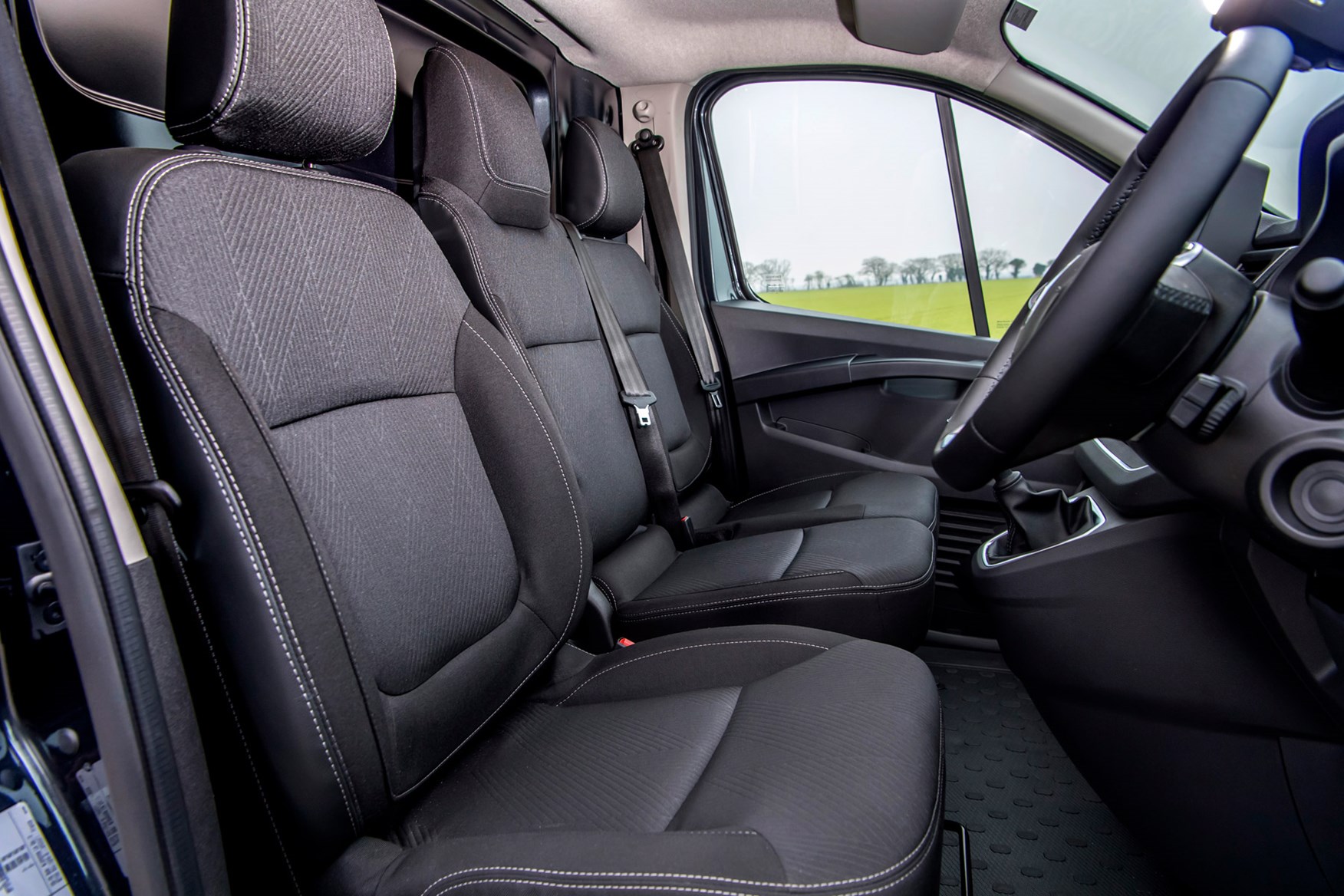
As before, 54 litres of space are tucked under the passenger bench seat. Similarly, the centre backrest still folds down to form a desk.
If you regluarly need to cary three people in a panel van of this size, the Trafic is a good choice. They are wider and more spacious in the cab than the Dispatch / Expert / Proace / Vivaro quartet, and actually offer the middle passenger some knee room.
- Typically impressive real-world fuel economy
- Four standard trim levels with lots of fitted kit
- Five-year finance and warranty packages available
Like many of the vans on sale in 2022, the Trafic has undergone a few price rises of late. The facelifted Trafic has seen its starting price go up by just under £3,000 since it launched in early 2022, although a reduction in November 2022 brought the starting price to £25,500 (before VAT). This still works out cheaper than the main rivals.
Renault Trafic mpg
Official fuel economy figures for the latest 2.0-litre Renault Trafic engines range from 39.2mpg to 40.4mpg according to the most recent WLTP standards.
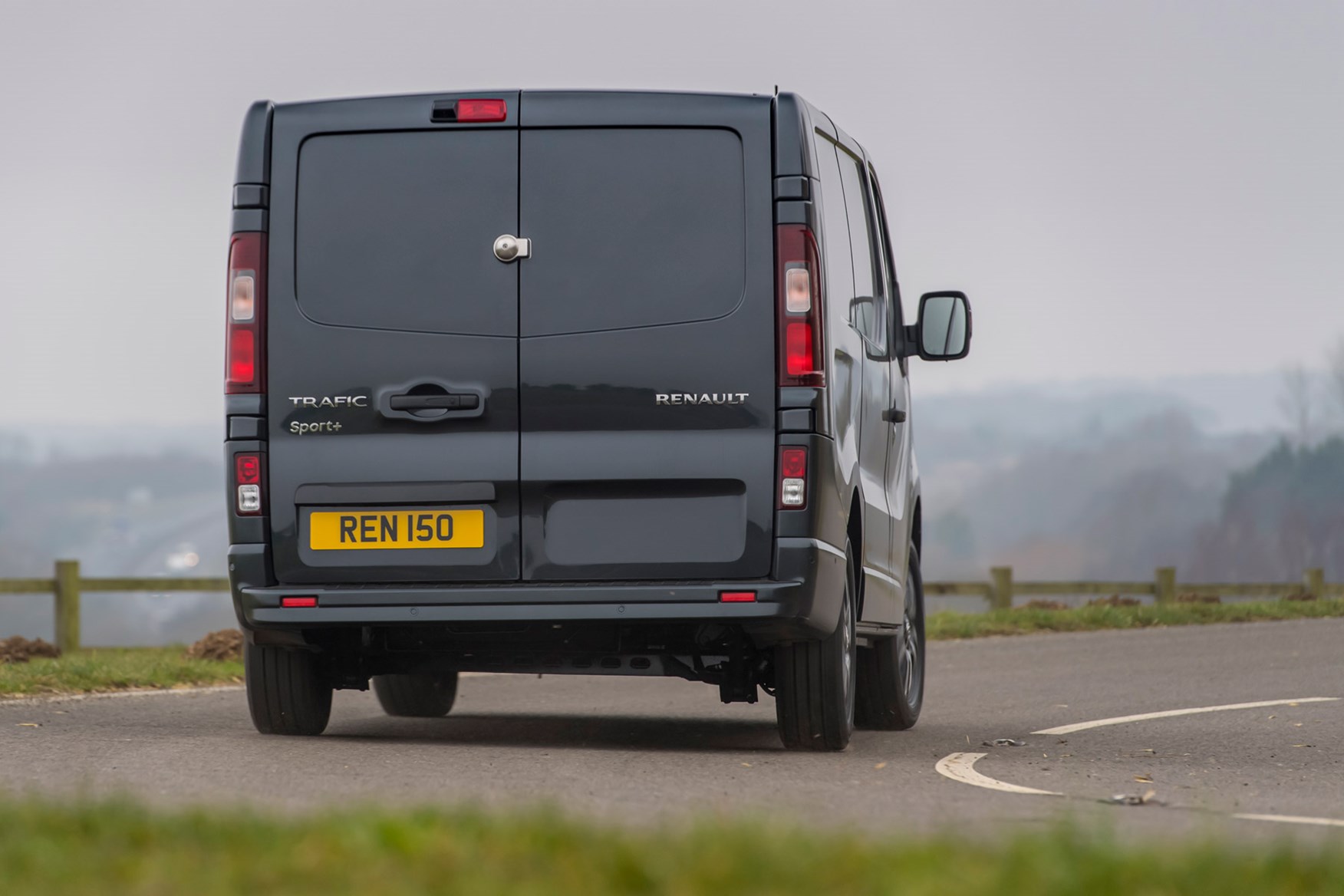
This is a bit of a drop from previous models on paper, but WLTP figures tend to better reflect real-world driving - and the Trafic has always been an impressively economical van in the real-world.
So the Trafic is a good choice if you’re looking to minimise your per-mile fuel costs. Stop-start technology comes on nearly every version (it's standard across the facelifted range, in fact).
Renault Trafic warranty
You get a three-year / 100,000-mile warranty and road-side assistance combo on the Trafic.
However, as part of the '5-year Pro+ Promise', launched in March 2021, Renault extended its standard warranty to five years / 100,000 miles for buyers taking out five years of HP finance. Sweetening the deal, the package also includes five years of servicing and five years of breakdown cover. You can also add
This was only due to run for a limited period, but is still going at the time of writing (November 2022).
Renault Trafic service intervals
The Trafic can travel up to 25,000 miles or for two years between servicing, whichever comes first.
Renault offers EasyLife service plans that allow you to spread the cost of maintenance.
>> Renault Trafic insurance via mustard.co.uk
Renault Trafic standard equipment
Following the 2022 facelift, the Trafic was offered in in four trim levels: Business, Business+, Sport and Sport+ - the latter being a new addition to the range. This then changed in late 2022 when the models were changed to Start, Advance, Extra and Extra Sport. The actual equipment is largely the same, with the name change the biggest difference.
Renault Trafic Start standard equipment highlights:
- 3.5-inch monochrome infotainment display with DAB radio, Bluetooth, aux-in connection and USB socket
- Height- and lumbar-adjustable driver’s seat with arm rest
- Reach and rake adjustable steering wheel
- Electric windows
- Heated, electric door mirrors
- Passenger bench seat
- Steel bulkhead
- Sliding side door on the passenger side
- Twin unglazed rear doors that open to 180 degrees
- Remote locking with alarm and immobiliser
- 16-inch steel wheels
- Full LED headlights
Renault Trafic Advance standard equipment highlights (in addition to Start):
- Manual air-conditioning
- Mobile Office – fold-down middle passenger seat with detachable A4 clipboard and laptop storage
- Underseat storage for passenger bench
- Body-coloured door rails
- Chrome grille for taillight column
- Load-through flap in bulkhead
- Wide View Mirror blindspot mirror in passenger sunvisor
- Rear parking sensors
- EasyLink 8.0-inch infotainement system with Apple CarPlay and Android Auto
Renault Trafic Extra standard equipment highlights (in addition to Advance):
- Automatic lights and wipers
- EasyLink with satellite-navigation and three-years' connected services
- 4.2-inch colour display in instrument cluster
- Premium dashboard with grain and chrome styling
- LED interior cabin lighting
- Body-coloured front bumper and door mirrors
- 17-inch alloy wheels
- Front fog lights
- Electric folding mirrors
- AEB as standard (more on the safety kit in the Safety section below)
Renault Trafic Extra Sport standard equipment highlights (in addition to Extra):
- Keyless entry
- Climate control
- Metallic paint
- Body-coloured side mouldings
- 17-inch alloy wheels with black inserts
- Rear parking camera
- Additional active safety
- Better build quality than many Renault cars
- If buying used, ensure all safety recall checks have been carried out
While the Trafic doesn't typically get outstanding results in reliability surveys, neither does its customer satisfaction get slated.
Renault has a comprehensive nationwide dealer network, including dedicated van centres called Pro+.
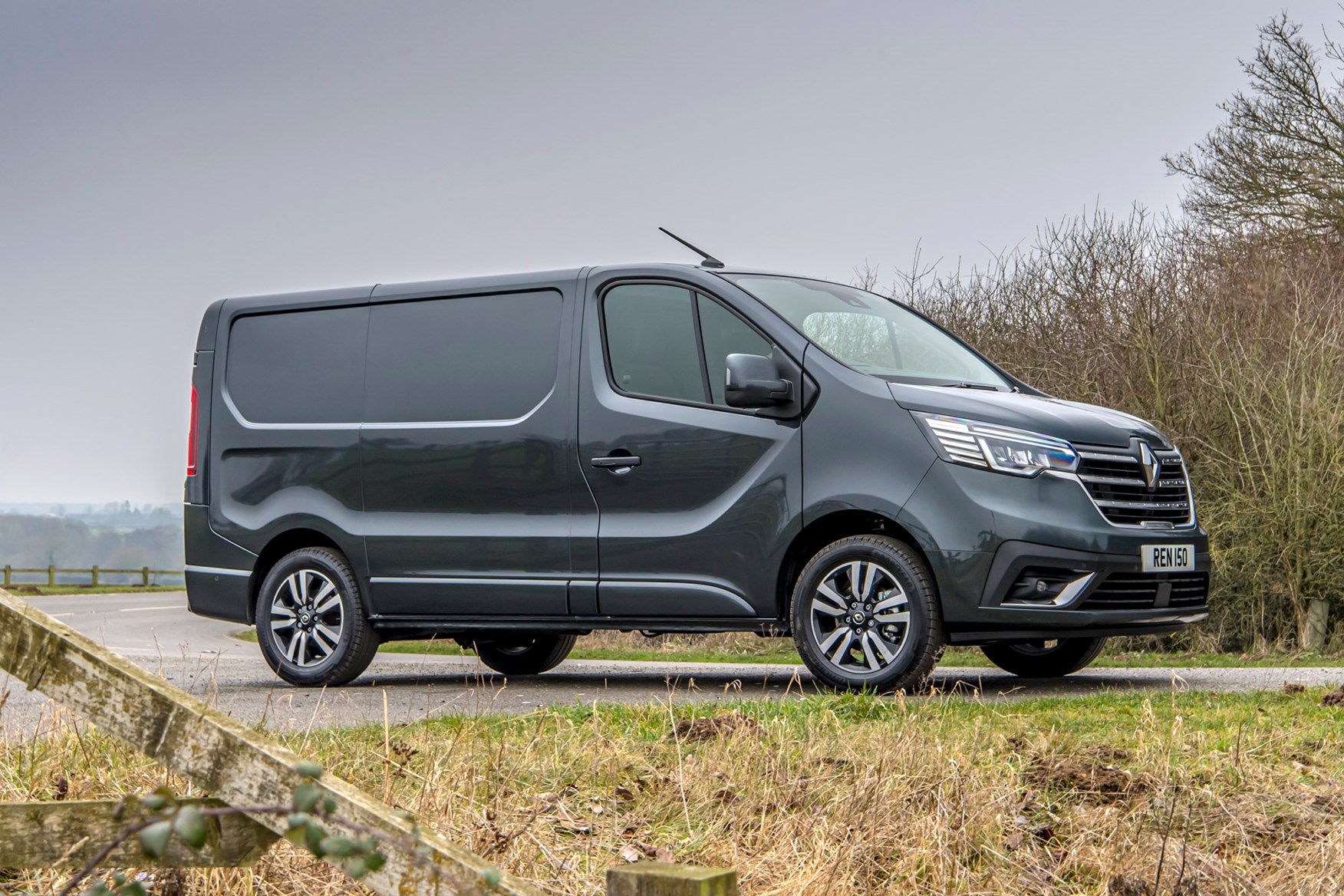
As most of the mechanical parts are shared with other models in the Renault range, keeping your Trafic roadworthy should a component fail, shouldn’t prove difficult.
Renault Trafic safety recalls
Having said all that, the 1.6-litre Trafic has been subject to some interesting safety recalls since it was introduced in 2014 - though these do mostly relate to early models, so newer examples should prove less problematic.
There are some fairly routine issues, such as the possibility of cracked exhaust gas recirculation (EGR) and potentially ineffective parking brakes.
But then there's one listed on the UK government's official recall checking website as 'rear axle may detach'. The one that suggests the 'bonnet may open without warning' also catches the eye.
It's important to remember that these are recall notices - so refer to mostly precautionary activities to ensure the vehicle's safety, rather than any deeply rooted problems.
- 2022 facelift brings substantial increase in safety kit...
- ...but only on higher-spec models
- Improved alarm fitted as standard
Having been severely criticised by Euro NCAP during the launch of its van safety campaign, Renault has vastly improved the Trafic's credentials as part of the 2022 facelift.
Renault Trafic safety
The Trafic is now available with all of the following Advanced Driver Assistance Systems (ADAS):
- Adaptive cruise control
- Lane-departure warning
- Blindspot warning
- Active emergency braking (better known as autonomous emergency braking)
- Traffic sign recognition
- Driver attention alert
- Automatic high and low beam for the full LED lights
All of these are optional extras on lower-spec models, however, with active emergency braking only standard from the Extra trim level, meaning 50% of the range doesn't get it.
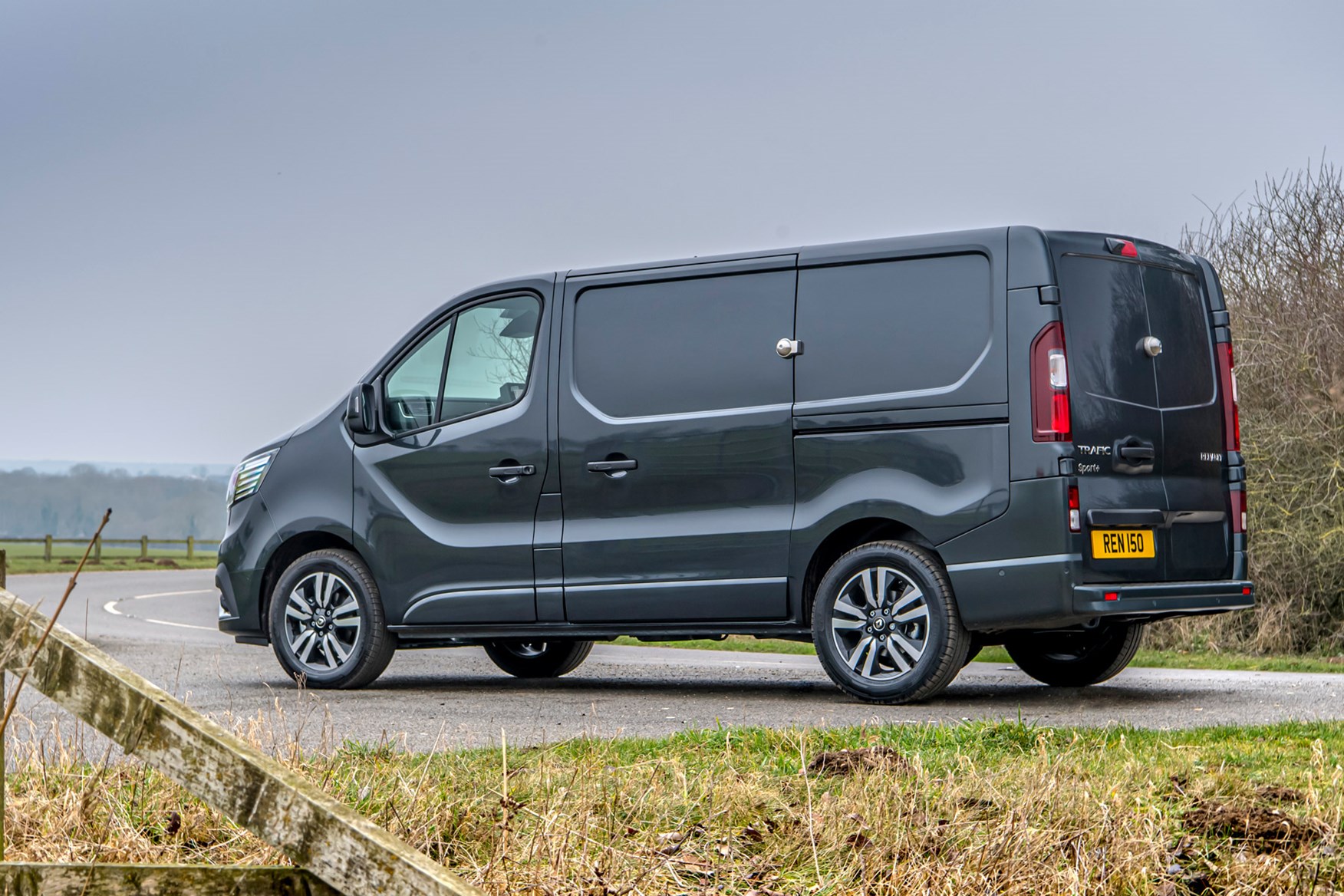
Every model is fitted with electronic stability control (ESC), however, complete with a Grip Xtend function to help keep you moving in tricky conditions. Still only one airbag, though.
Renault Trafic security
The Trafic is one of only a few vans that gets an alarm as standard across the whole range, and for the 2022 facelift this has been upgraded from perimeter to volumetric technology.
An Extra Security Lock is also available, with further lock upgrades offered via Renault Pro+ dealerships.
Which Renault Trafic is best for me?
Need a little more information about which trim level or engine to go for? We've got your back.
Which is the best Renault Trafic trim level?
Traditionally, the bestselling van trim has always been the entry-level model, but these days more and more medium vans are being sold in higher specifications.
The UK doesn't even take the most basic Trafic variant, starting at well-equipped Start trim instead, but most buyers will opt for Advance , which includes such creature comforts as air-conditioning and useful features such as rear parking sensors.
Which is the best Renault Trafic engine?
If you're looking at a 1.6-litre model, we'd strongly suggest going for the extra performance (and efficiency) of one of the twin-turbo models.
We're yet to try the less-powerful 2.0-litre engines, but found the 145hp version more than adequate when equipped with the excellent EDC automatic, and believe this engine will provide all the power most users will need.
The 170hp is notably faster, but also likely to provoke increased front tyre wear, so is perhaps best left to those with particularly heavy loads to haul or a keen need to impress their mates down the pub.
Renault Trafic individual model reviews
Looking for more information about individual Renault Trafic models? We've driven the following variants extensively:
- Renault Trafic SL27 1.6 dCi 145 Formula Edition - tested January 2018
- Renault Trafic SL27 1.6 dCi 125 Sport Nav Euro 6 - tested January 2017
Renault Trafic Formula Edition review
Tested January 2018 by CJ Hubbard
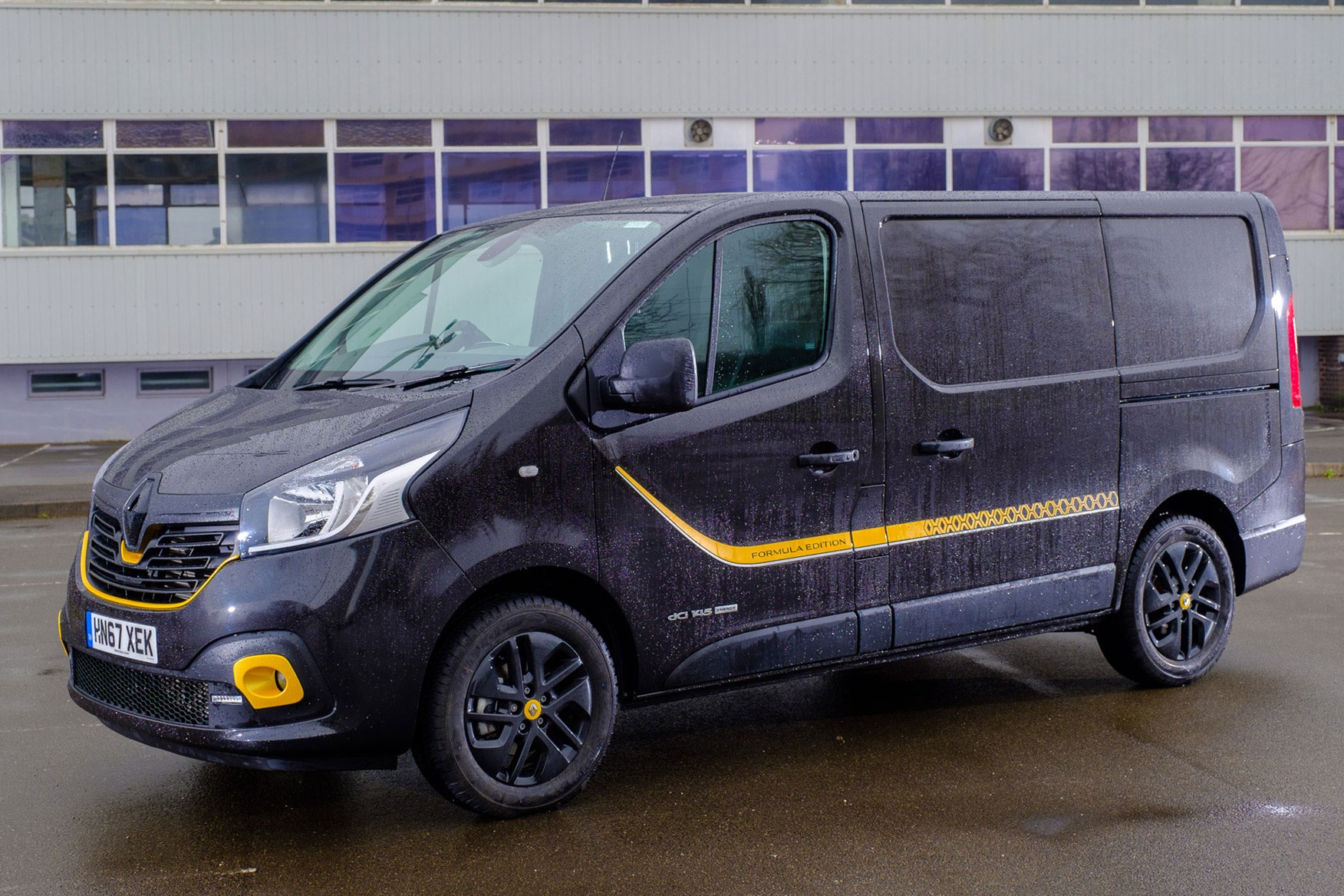
- Sharp, sporty looks for Renault’s mid-size van
- Celebrates links with Renault F1 team
- Comfy and good to drive but modest power and payload
After a distinctly different sporty looking van that still comes with a bit of a proper pedigree image? Then the Renault Formula Editions could be for you. Biggest seller is likely to be the Renault Trafic Formula Edition in the medium van sector, which we’ve got for review here – but matching versions of both the Kangoo small van and Master large van are also available.
Just one thing, though: you’d better like black and yellow…
Whoa. The Renault Trafic Formula Edition is certainly striking to look at
Yep. Finished in Pearlescent Black with Sirius Yellow detailing, it sure does stand out – so it’ll be pretty easy to find again in the carpark.
Neat details include the blacked-out Renault badge, grille and 17-inch alloy wheels; we’re not so taken with the yellow foglight surrounds. On the inside there’s a standard-fit Luxe pack (more details below) and special Formula Edition mats.
How the looks compare to the likes of the Ford Transit Custom Sport or the VW Transporter Sportline is probably a matter for personal preference. And how much you like yellow.
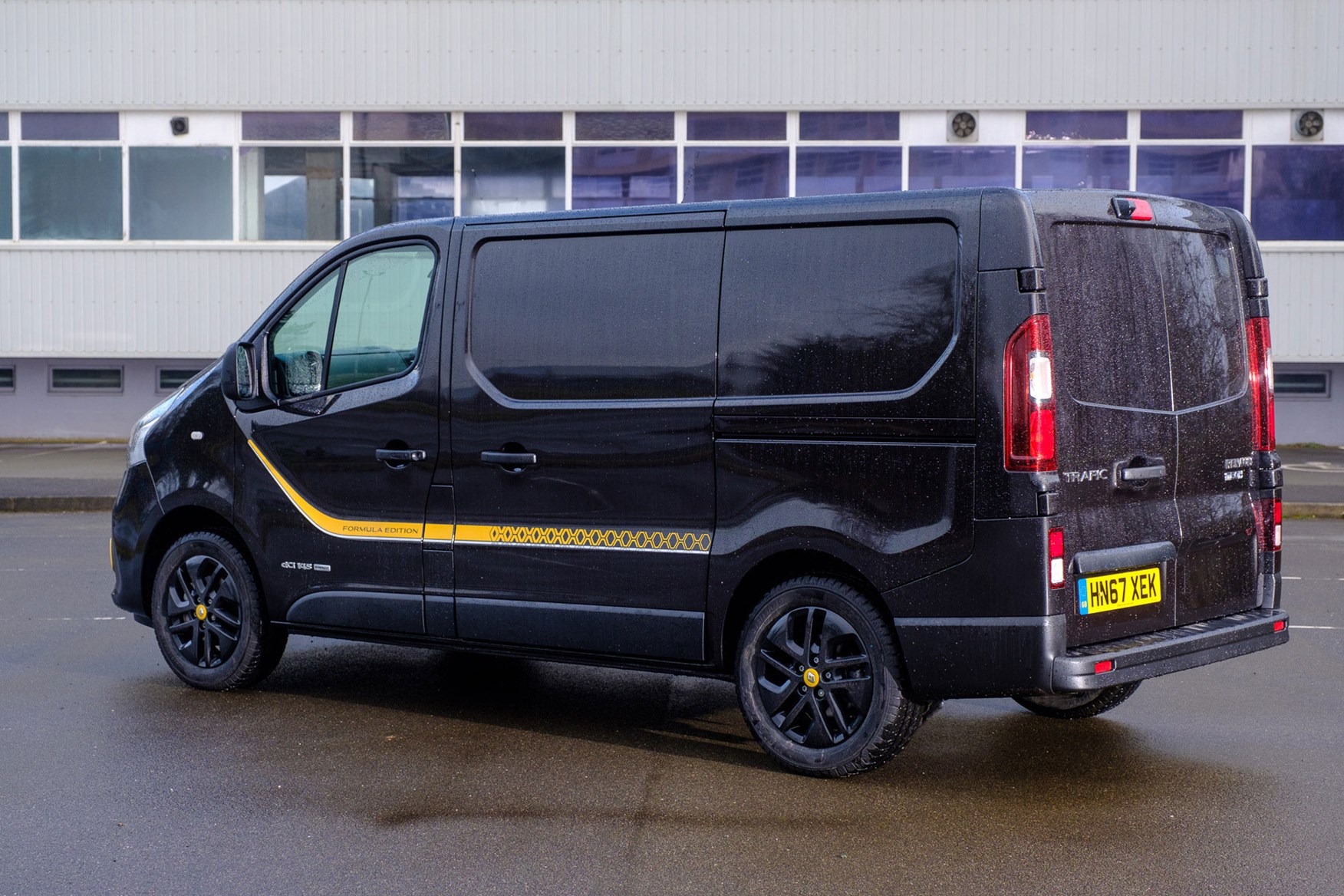
Beyond the eye-catching colouring, you might argue Renault hasn’t actually gone far enough in the transformation. Compared with both the Ford and – especially – the VW, the Trafic’s physical alteration is really rather mild.
But then, you might also be glad it lacks a ground-hugging front bumper the next time you’re faced with a particularly aggressive sleeping policeman.
What was that about the Renault Trafic Formula Edition having proper pedigree?
The clue is in the name – these vans celebrate the link between the Renault Pro+ light commercial vehicle (LCV) business and the Renault Formula 1 team.
Tenuous, maybe, but Renault F1 does use Renault vans as support vehicles.
In terms of the Trafic range, the Formula Edition sat alongside the regular Sport model as an upgrade to the Business+ specification. And unlike those rival sporty vans, its added bells and whistles are available on all Trafic engine options as well as both short and long wheelbase lengths – though only the standard low one rather than high roof.
Is the Formula Edition faster than a regular Renault Trafic?
Sadly, no. This is a van in a fancy suit, not an F1 car in disguise. The best you can hope for is the top-spec 145hp twin-turbo version of the Trafic’s regular 1.6-litre diesel engine, which we’re testing here.
There’s no particular shame in this – it’s a smooth, surprisingly potent engine.
And for all that it’s significantly out-gunned on paper by those Ford and VW rivals, which boast 170hp and 204hp respectively, in isolation you’re rarely going to find yourself wishing this Renault was faster: 0-62mph is quoted at just 10.9 seconds.
So the Renault Trafic Formula Edition is good to drive?
Really good. Not that this should be a surprise – the Trafic was already one of the best vans to drive, and there are no changes to the Formula Edition that might ruin this.
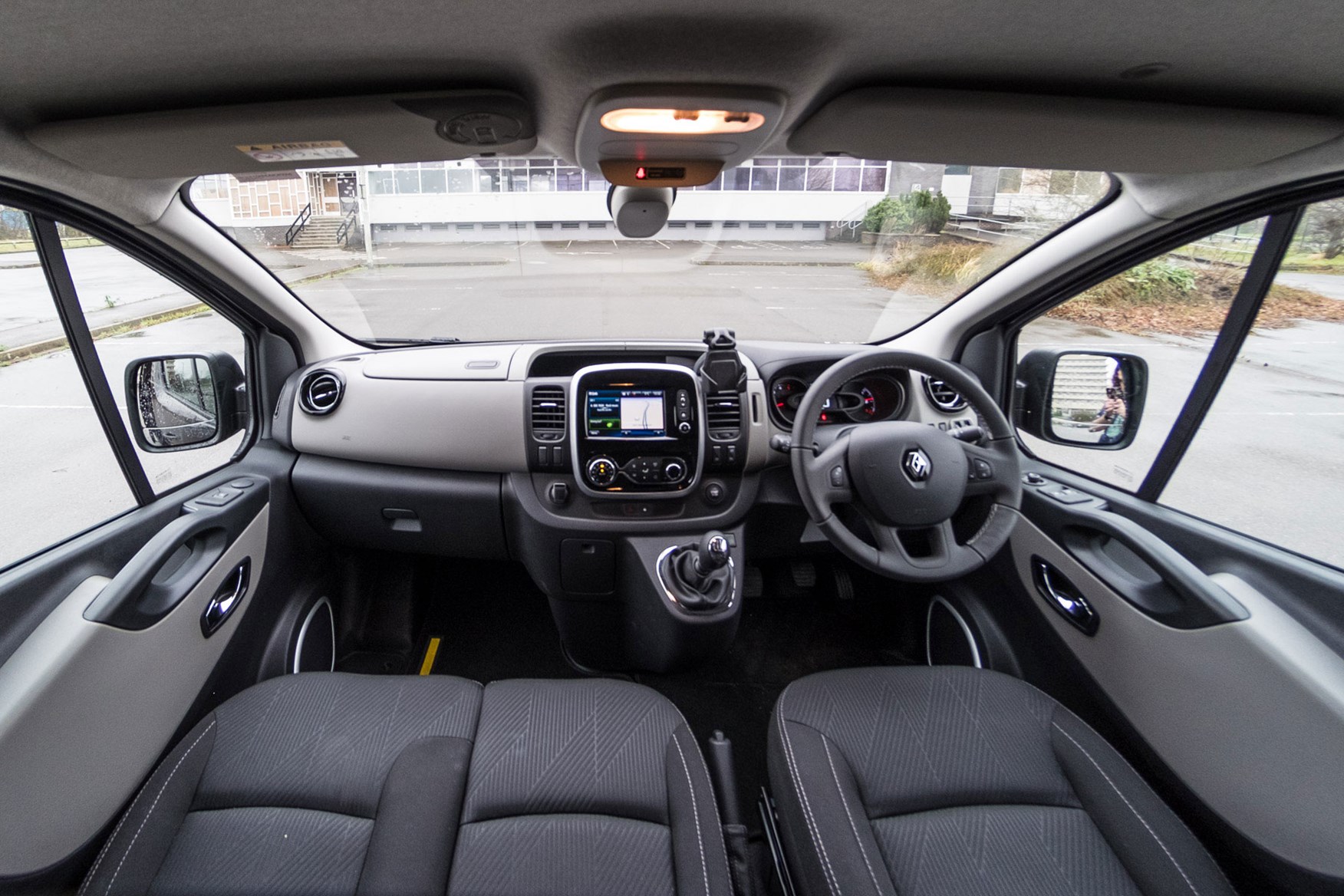
A nicely mechanical and pleasingly quick-shifting six-speed manual gearbox puts most of Renault’s car transmissions to shame, helping to make the most of the impressive engine – which really does go very well for just 1.6 litres in a sector where the best rivals have 2.0-litre power.
With 340Nm of torque it should still cope with the Formula Edition’s modest maximum payload capacity just fine, while typically delivering real-world fuel economy to shame most medium rivals. Great motor.
Better yet is the Trafic’s tidy handling. Not only does it ride bumps well – despite the 17-inch wheels, and even when unladen – bodyroll is limited, predictable and controlled, while the keen steering provides an unexpected level of detail and feedback for a van.
This makes the Trafic fun on a B-road, and the driver confident in the throes of city-centre, uh, traffic.
The standard-fit electronic stability control system also features a Grip Xtend function, improving traction in slippery conditions such as snow and ice as well as mud. Don’t expect to go off-roading, but it could get you out of trouble.
What’s the Renault Trafic Formula Edition like in the cab?
The test van was awash with optional extras – including the car-like R-Link infotainment console with sat-nav, a climate control system, keyless go and handy reversing camera, not to mention additional curtain and passenger airbags – but even so, the Formula Edition is a comfortable place to spend time.
Supportive, comfy seats and clear dials cover the basics, while the Luxe pack standard on this model adds a touch of extra quality with its leather-finished gearknob, satin radio and speaker surrounds, gloss black air vents, chrome detailing and closed upper glovebox area.
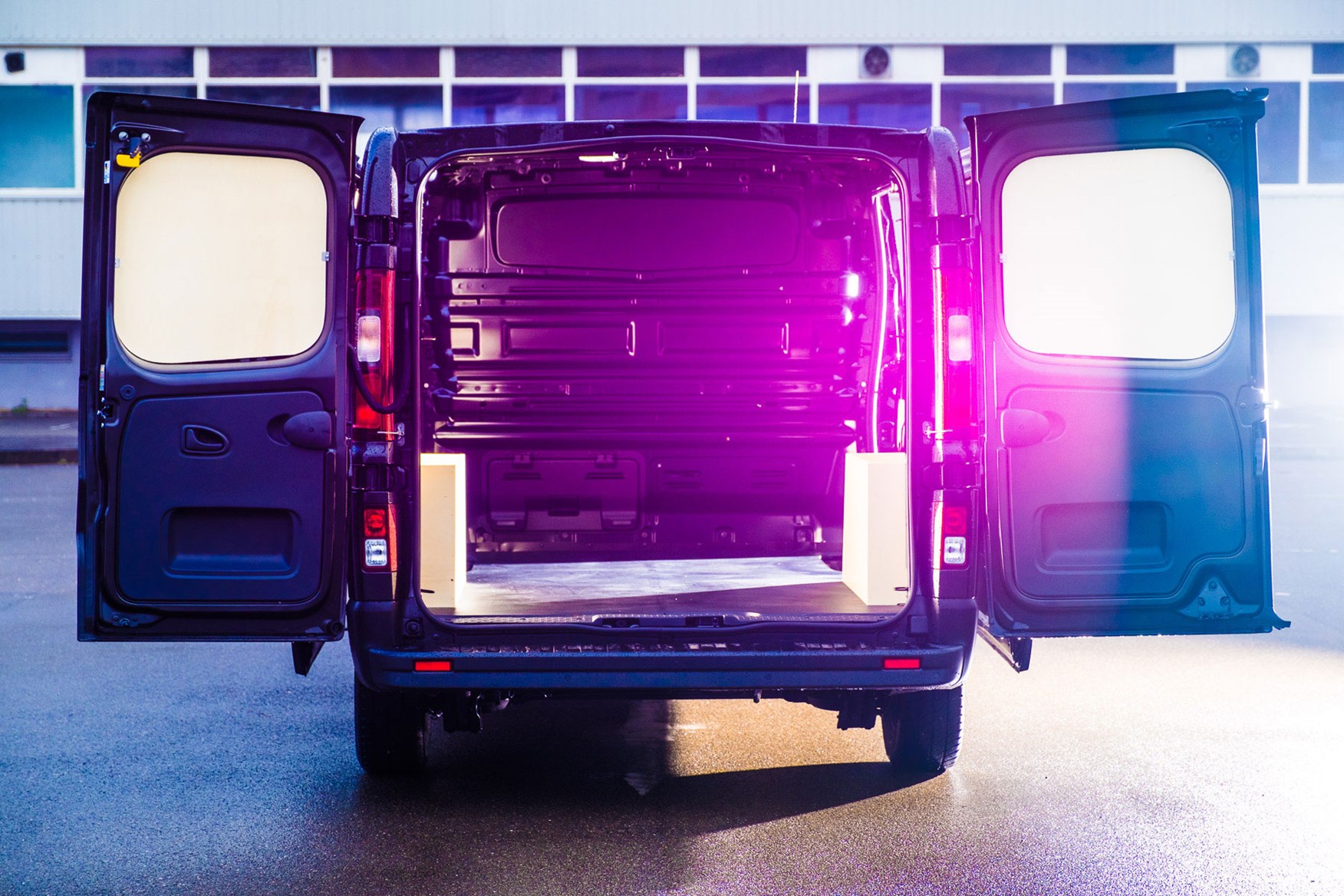
If you’re not familiar with Renault’s control layout it might take you a short time to get used to the position of things such as the steering column-mounted audio controls – and it’s a shame the buttons on the steering wheel for the cruise control aren’t illuminated, making them tricky to use at night – but otherwise everything is very user-friendly.
In fact, we’d argue Renault’s designers have gone a little too far in making the Trafic homely, as one of our routine criticisms of this van is the lack of useful storage in the cab.
Should I buy a Renault Trafic Formula Edition
One of the nicest driving vans around, the Renault Trafic is certainly a top choice for those who do lots of miles over lots of different types of road – but aren’t worried about maximising payload capacity.
Priced from £25,850 (ex-VAT) with this, the most powerful engine option, the Formula Edition is good value, and the attention-grabbing looks could be a great way to promote your business.
On the other hand, if you’re not sold on the black and yellow, the regular Trafic has all the same strengths with added subtlety.
Renault Trafic Sport Nav review
Tested January 2017 by CJ Hubbard
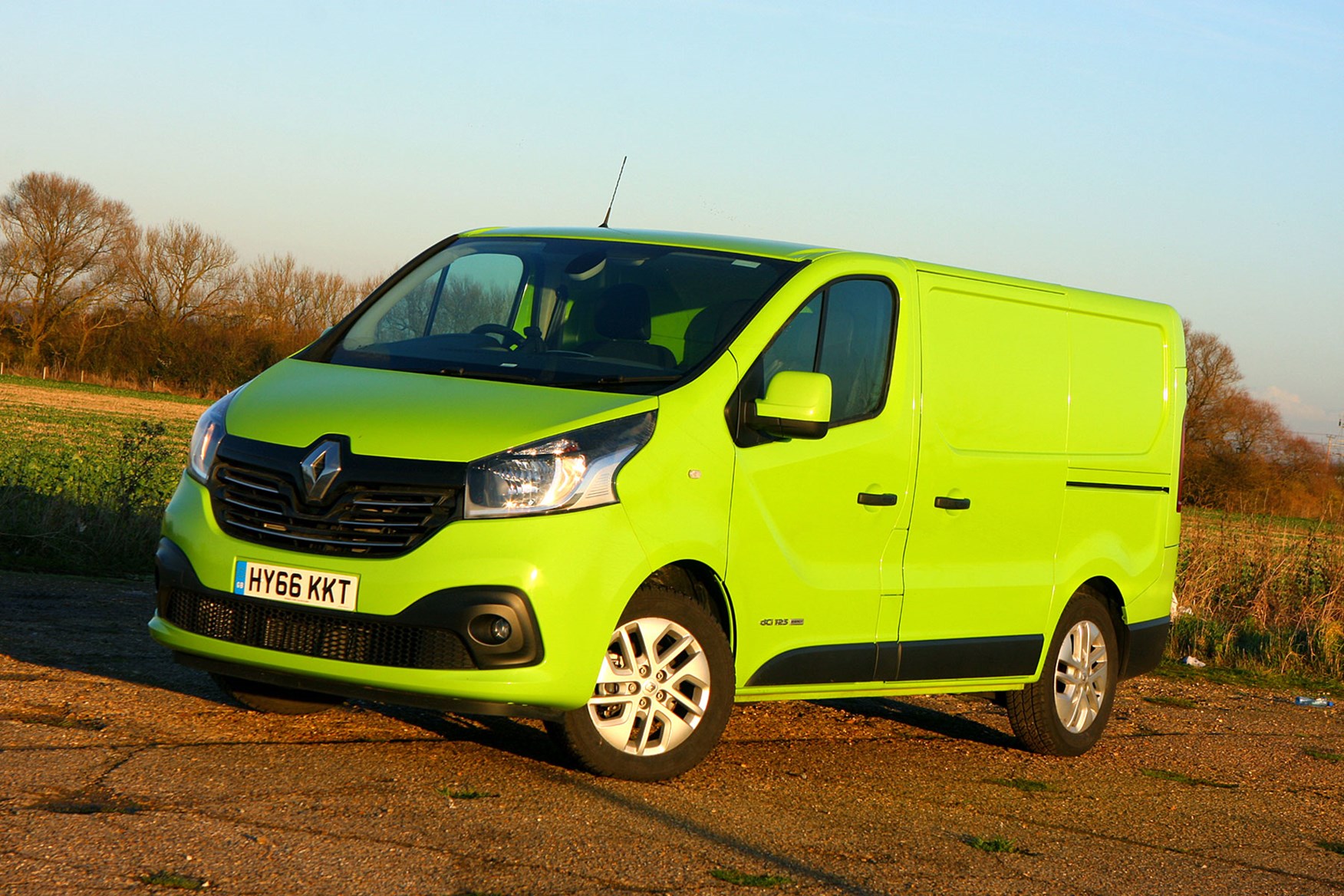
- No significant performance upgrade with Euro 6 engine
- BUT refinement and comfort are exceptional for a van
- Large load area but limited payload, four-year warranty
This is our first crack at the Renault Trafic medium-duty van with a Euro 6 engine. The Trafic was the seventh best-selling van of 2016, and the new engine range – which brings more power and improved fuel efficiency at the expense of extra weight – should see this success continue into 2017.
Renault has also been the best-selling commercial vehicle manufacturer in Europe for the past 18 consecutive years, so it’s fair to expect it to know what it’s doing.
Which Renault Trafic is on test?
In this instance we’re testing the Renault in SL27 Energy dCi 125 Sport Nav specification. That means it’s the Short body length, Low-roof version with the smallest gross vehicle weight (GVW) rating, powered by a 125hp twin-turbo 1.6-litre diesel engine.
Sport is the top trim level, above Business and Business+, while Nav means satellite-navigation is fitted.
What’s the Trafic’s new Euro 6 dCi 125 engine like?
The entire engine line-up gains 5hp over the old equivalents, so there isn’t a massive leap in performance. Fuel economy for the dCi 125 is a claimed 47.2mpg – which is a mere 0.1mpg more than the old twin-turbo dCi 120 engine.
So it hardly seems worth the expense of the newly fitted AdBlue tank, which is now needed to make the Euro 6 emissions control systems work. Although it is some 3.6mpg better than the single-turbo dCi 120 Euro 6 engine also offered in the Trafic.
Fortunately, the extra heft of these items has been counterbalanced on most Trafics by increasing the gross vehicle weight; this particular van is up to 2,820kg GVW, leaving room for a 1,077kg payload.
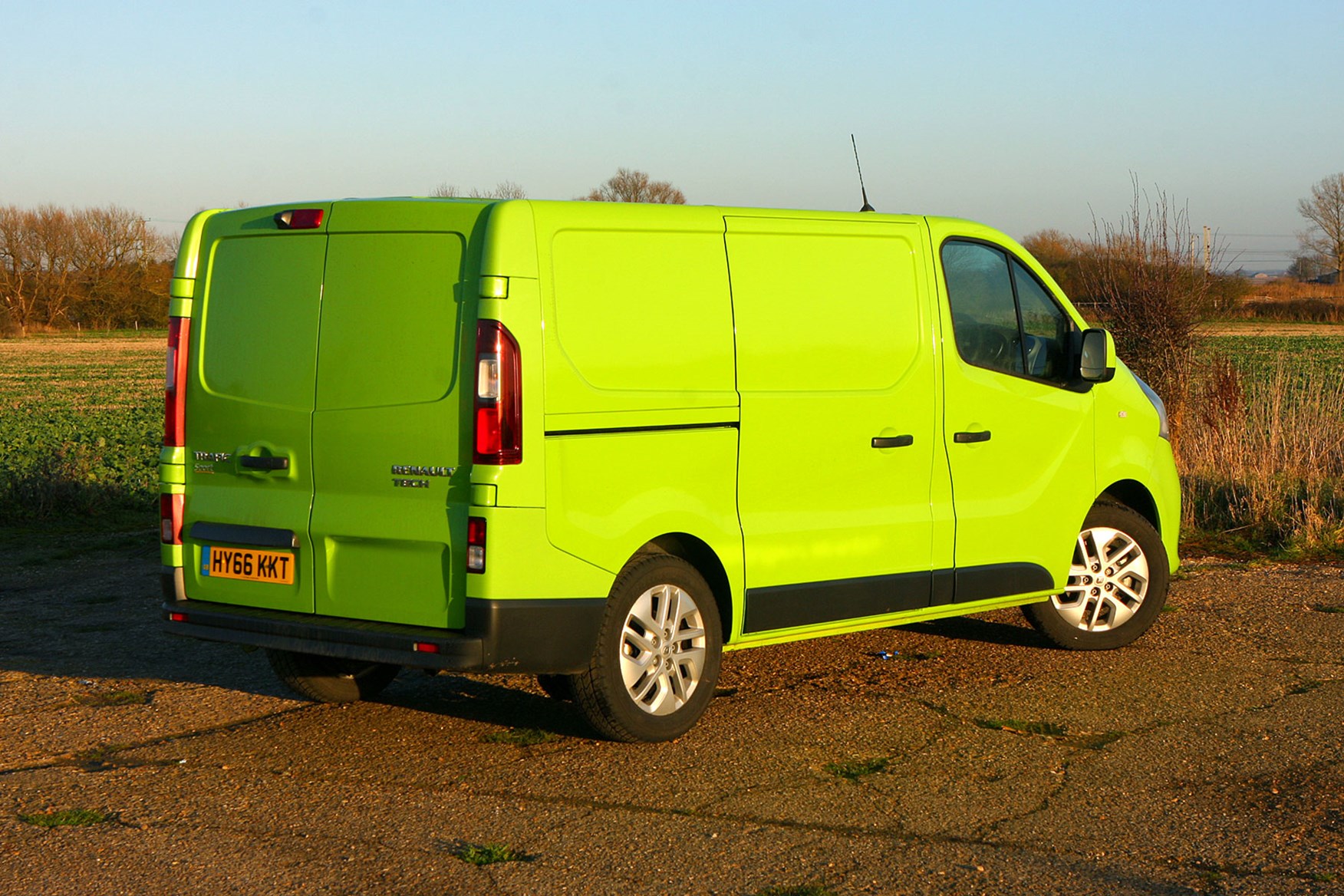
On top of which, AdBlue helps reduce those nasty NOx emissions, which are physically harmful to the environment. The Energy badging means this Trafic is equipped with start-stop, which works seamlessly.
More importantly to most operators, this is an excellent engine. With 320Nm of pulling power this is smooth and powerful – so much so that you can actually use the (supposedly) fuel-saving Eco driving mode without feeling like someone’s added an anchor to the back – and incredibly refined.
There are few quieter van choices in any area of the market. Genuinely: excellent.
Driving experience
In fact, we’d apply the word excellent to the entire driving experience. Renault has made no secret of raiding the parts bin of its car division here, and with suspension components derived from its people carriers, the Trafic is direct and confidence-inspiring from behind the wheel.
Steering assistance is very well judged, being light enough to make tight manoeuvres easy but with enough substance to ensure the Trafic feels superbly stable at motorway speeds. The shift action for the six-speed gearbox is mechanical and precise, and it’s easy to find a comfortable driving position.
What’s more, the ride quality is exceptional for a van – particularly when travelling unloaded, which usually results in a harsh and bouncy rear. You will be able to cover big distances in one of these with very little complaint.
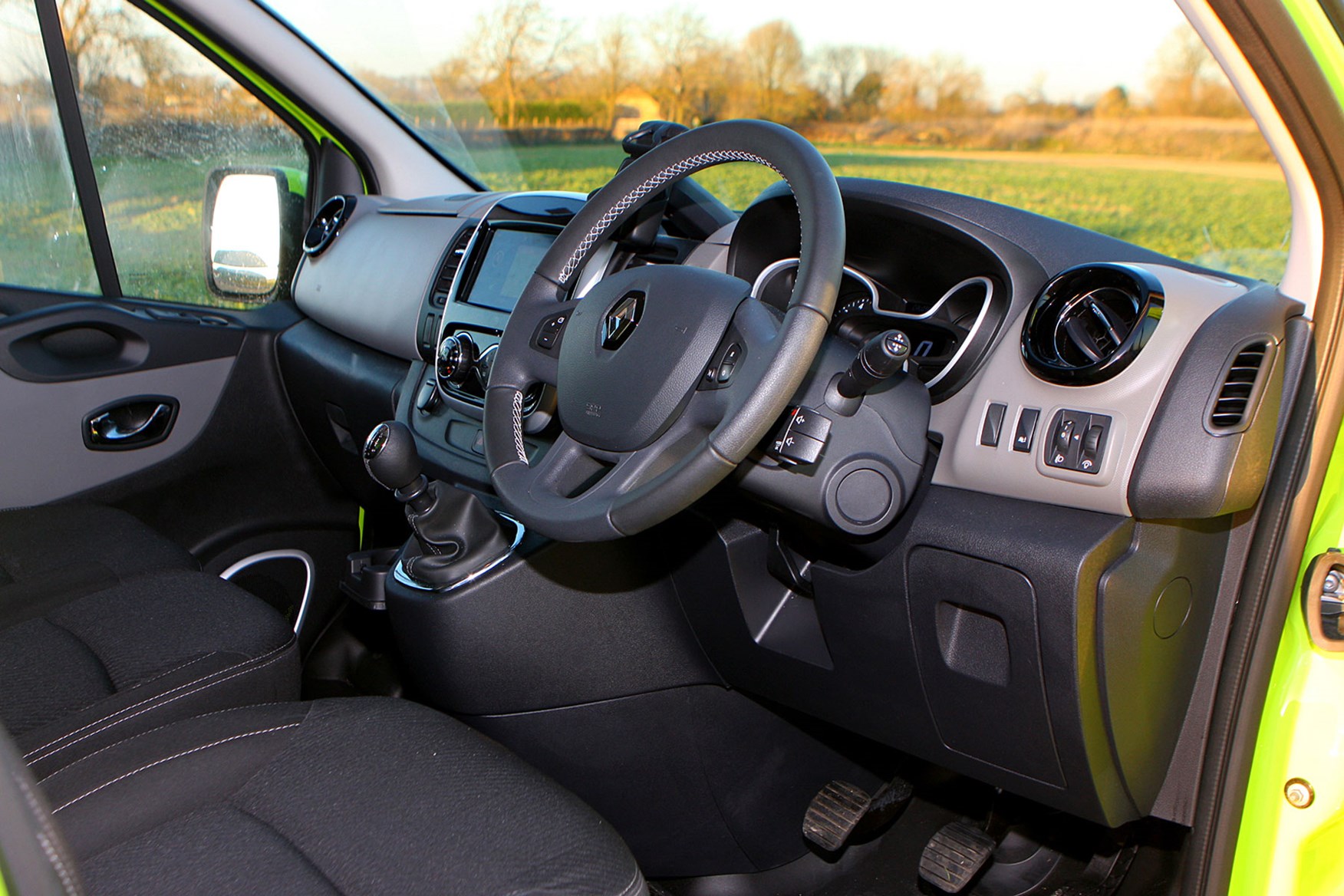
Renault even includes a low-traction mode as standard in addition to the usual electronic stability control, helping you get a grip on slippery surfaces such as gravel and light snow.
Car-derived mobile office
There are more car-derived elements in the cab. The entire centre console area with air-conditioning controls and sat-nav infotainment screen looks like it could have been lifted directly out of a Clio, and the rubber-trimmed adjustment dials are again of the very highest quality in van terms.
The infotainment takes a bit of figuring out, but this comes with time, and the major instruments are clear and modern. Renault has also incorporated a number of mobile office elements: the middle seat back folds down to form a desk, there are laptop and tablet holders available, plus a built-in clipboard. Great, functional stuff. Most of the cubbies have covers, too.
However, nothing is perfect and the Trafic is no exception. The built-in mobile phone holder is too small for a Samsung Galaxy S7 – which means it will be too small for plenty of other modern smartphones, too – the door trims are more style than substance with limited storage space, and the fixed steel bulkhead of our test example rattled continuously.
Renault Trafic SL27 load area
The interior wood panelling was finished to an extremely high standard on our test van, and there were no fewer than 16 load lashing points in the back, not including the optional internal roof rack that was also fitted. This comes with a reinforced panel to protect the bulkhead from damage.
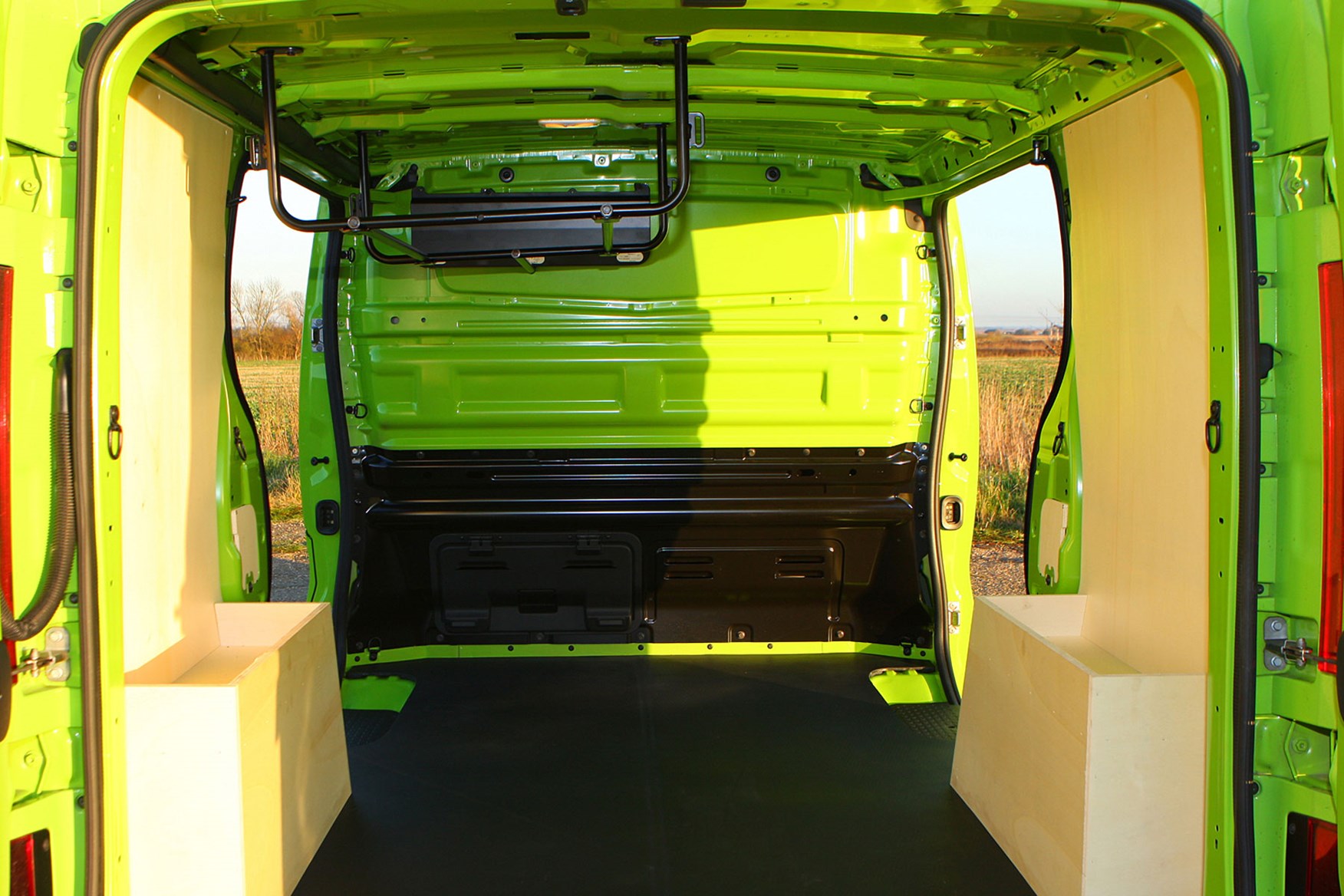
Renault also offers full racking solutions.
Should I buy a Renault Trafic Sport Nav?
Shopping for a medium van? The Renault Trafic isn’t the best option for those seeking the heaviest possible payload rating, but in all other respects it should be right near the top of your list. And the dCi 125 engine is a great choice – more efficient than the lesser alternatives, powerful enough to make the pricey dCi 145 at the top of the range seem an unnecessary extravagance.
That said, it’s also worth checking out the Nissan NV300, because it’s a very similar van that comes with a five-year warranty.



